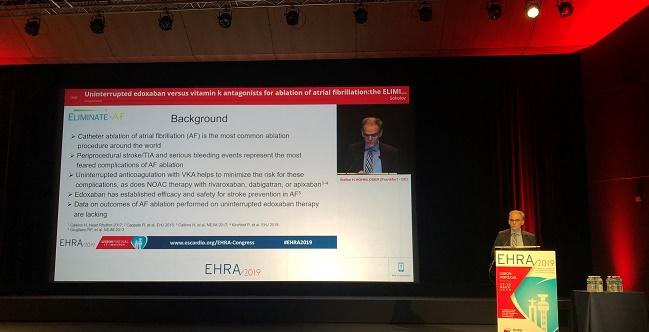Edoxaban Joins Other NOACs as Option During Catheter Ablation for A-fib
All four non-vitamin K antagonist oral anticoagulants have now fared well versus warfarin in this setting, although larger studies are lacking.

LISBON, Portugal—Use of uninterrupted edoxaban (Savaysa; Daiichi Sankyo) during catheter ablation for A-fib is associated with rates of thromboembolic and bleeding events that are low and comparable to those seen with a vitamin K antagonist (VKA), the ELIMINATE-AF trial shows.
The rate of the primary composite endpoint of death, stroke, or ISTH major bleeding in the postablation period was 0.3% in the edoxaban arm and 2.0% in the VKA arm in the main per-protocol analysis, Stefan Hohnloser, MD (Johann Wolfgang Goethe University, Frankfurt, Germany), reported at the European Heart Rhythm Association Congress 2019.
There were no deaths in study and two strokes (one ischemic and one hemorrhagic), both in edoxaban-treated patients. ISTH major bleeding occurred in 2.5% of patients receiving edoxaban and 1.5% of those treated with a VKA.
None of the between-group differences were statistically significant. Like trials of the other non-VKA oral anticoagulants (NOACs), however, ELIMINATE-AF was not powered to make formal comparisons, and the results are considered descriptive only.
Nevertheless, the findings—due to be published in the European Heart Journal—show “that uninterrupted edoxaban treatment represents an alternative to continuous anticoagulation with VKA in these patients,” Hohnloser said.
Balancing Feared Complications
Periprocedural stroke and serious bleeding are the most feared complications of A-fib ablation, Hohnloser said. Prior studies have shown that uninterrupted anticoagulation with a VKA during the procedure helps minimize those risks, with later NOAC trials—VENTURE-AF for rivaroxaban (Xarelto; Bayer/Janssen), RE-CIRCUIT for dabigatran (Pradaxa; Boehringer Ingelheim), and AXAFA-AF-NET for apixaban (Eliquis; Bristol-Myers Squibb)—showing a similar benefit.
ELIMINATE-AF now provides information in this setting for edoxaban. The open-label trial randomized 614 patients undergoing a first or repeat A-fib ablation 2:1 to uninterrupted edoxaban or VKA. Patients were treated for at least 21 days before the procedure and then checked with echocardiography to ensure the absence of clots. After undergoing ablation, the patients continued treatment for another 90 days and were then followed for an additional month.
In the VKA arm, Hohnloser reported, average time in therapeutic range was good at 64.1% in an analysis of patients who received the study drug and underwent ablation. Treating physicians were advised to use unfractionated heparin to maintain an ACT above 300, and a higher average dose was required to do so in the edoxaban group.
In a per-protocol analysis, the rate of the composite of death, stroke, or ISTH major bleeding was 1.3% in the edoxaban arm and 3.0% in the VKA arm during peri- and postablation periods. In the modified intention-to-treat analysis incorporating patients who underwent ablation, the respective rates were 2.7% and 1.7%. Neither difference was statistically significant.
The primary safety endpoint was ISTH major bleeding in the overall study period, and again this did not differ between groups. Cardiac tamponade was rare, with just three cases in the edoxaban arm and two in the VKA arm. Major bleeding unrelated to the procedure was seen in four patients, all treated with edoxaban.
NOACs as Alternatives to VKAs
Serving as a discussant following the presentation, Tatjana Potpara, MD, PhD (Belgrade University, Serbia), said it’s not easy to find the delicate balance between reducing the transient thromboembolic risk associated with A-fib ablation and minimizing the risk of serious bleeding with oral anticoagulation.
In that context, ELIMINATE-AF and the trials testing the other NOACs versus VKAs in the setting of A-fib ablation show “reassuringly low” event rates, she said.
“These trials add information and can help in daily practice, but please note there are limitations, some of them already mentioned,” Potpara said, citing open-label designs and sample sizes that are 10 to 15 times smaller than would be needed for formal statistical comparisons between NOACs and VKAs. “So they are . . . purely exploratory trials,” she said.
Even so, Potpara said, the trials demonstrate low rates of death, ischemic stroke, and major bleeding and the feasibility of using NOACs in this setting.
“Periprocedural anticoagulation with NOACs is an alternative to uninterrupted vitamin K antagonist [therapy], at least in relatively young [and] low-to-moderate-stroke-risk patients,” Potpara concluded. “However, should we change clinical practice in terms of switching patients from one OAC agent to another only for the purpose of ablation? Well, there is no solid evidence to guide such practice.”
Todd Neale is the Associate News Editor for TCTMD and a Senior Medical Journalist. He got his start in journalism at …
Read Full BioSources
Hohnloser SH. Uninterrupted edoxaban versus vitamin K antagonists for ablation of atrial fibrillation: the ELIMINATE-AF trial. Presented at: EHRA 2019. March 18, 2019. Lisbon, Portugal.
Disclosures
- Hohnloser reports having served as a consultant, advisor, and/or speaker for Abbott (St. Jude Medical), Bayer Healthcare, Bristol-Myers Squibb, Boehringer Ingelheim, Boston Scientific, Cardiome, Daiichi Sankyo, Gilead, Johnson & Johnson, Medtronic, Otsuka, Pfizer, Portola, Sanofi Aventis, Servier, and Zoll.
- Potpara reports no relevant conflicts of interest.


Comments